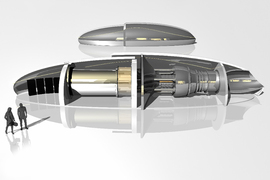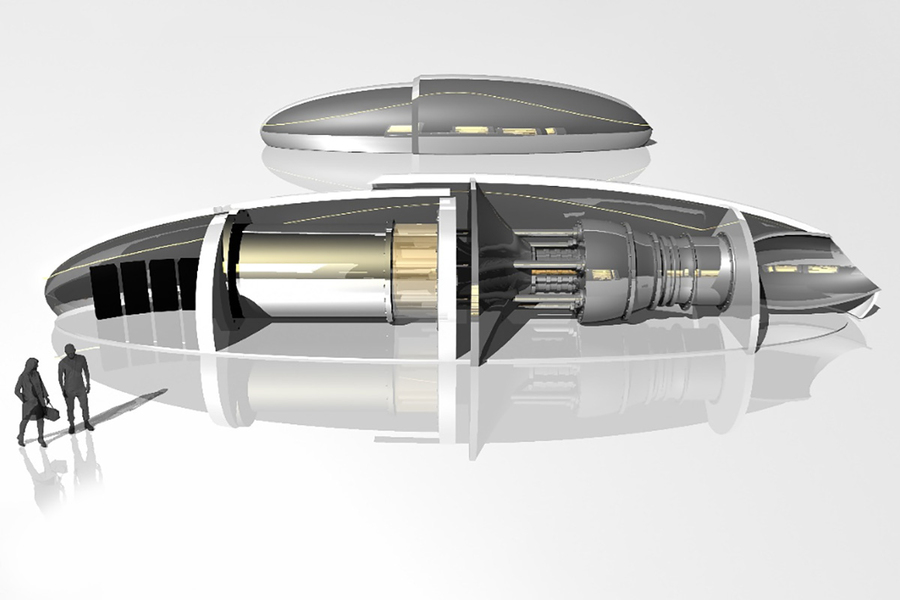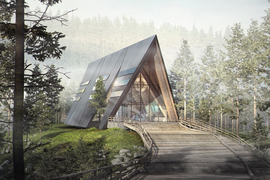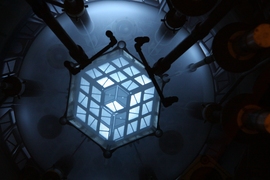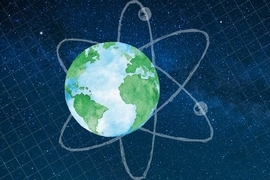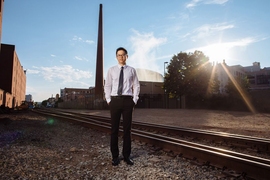We may be on the brink of a new paradigm for nuclear power, a group of nuclear specialists suggested recently in The Bridge, the journal of the National Academy of Engineering. Much as large, expensive, and centralized computers gave way to the widely distributed PCs of today, a new generation of relatively tiny and inexpensive factory-built reactors, designed for autonomous plug-and-play operation similar to plugging in an oversized battery, is on the horizon, they say.
These proposed systems could provide heat for industrial processes or electricity for a military base or a neighborhood, run unattended for five to 10 years, and then be trucked back to the factory for refueling and refurbishment. The authors — Jacopo Buongiorno, MIT’s TEPCO Professor of Nuclear Science and Engineering; Robert Frida, a founder of GenH; Steven Aumeier of the Idaho National Laboratory; and Kevin Chilton, retired commander of the U.S. Strategic Command — have dubbed these small power plants “nuclear batteries.” Because of their simplicity of operation, they could play a significant role in decarbonizing the world’s electricity systems to avert catastrophic climate change, the researchers say. MIT News asked Prof. Buongiorno to describe his group’s proposal.
Q: The idea of smaller, modular nuclear reactors has been discussed for several years. What makes this proposal for nuclear batteries different?
A: The units we describe take that concept of factory fabrication and modularity to an extreme. Earlier proposals have looked at reactors in the range of 100 to 300 megawatts of electric output, which are a factor of 10 smaller than the traditional big nuclear reactors at the gigawatt scale. These could be assembled from factory-built components, but they still require some assembly at the site and a lot of site preparation work. So, it's an improvement over the traditional plants, but it's not a game changer.
This nuclear battery concept is really a different thing because of the physical scale and power output of these machines — about 10 megawatts. It's so small that the whole power plant is actually built in a factory and fits within a standard container.
This provides several benefits from an economic point of view. Deploying these nuclear batteries does not entail managing a large construction site, which has been the primary source of schedule delays and cost overruns for nuclear projects over the past 20 years.
The nuclear battery is deployed quickly, say in a few weeks, and it becomes a sort of energy on demand service. Nuclear energy can be viewed as a product, not a mega-project.
Q: You talk about potentially having such units widely distributed, including even in residential areas to power whole neighborhoods. How confident can people be as to the safety of these plants?
A: The nuclear battery designs that are being developed are exceptionally robust; that's actually one of the selling points for this technology. The small physical size helps with safety in various ways. First, the amount of residual heat that has to be removed when the reactor is shut down is small. Second, the reactor core has a high surface-to-volume ratio, which also makes it easier to keep the nuclear fuel cool under all circumstances without any external intervention. The system essentially takes care of itself.
Third, the reactor also has a very compact and strong steel containment structure surrounding it to protect against a release of radioactivity into the biosphere. To enhance security, we envision that at most sites these nuclear batteries would be located below grade, to provide an additional level of protection from an attacking force.
Q: How do we know that these new kinds of reactors will work, and what would need to happen for such units to become widely available?
A: NASA and Los Alamos National Laboratory demonstrated a microreactor for space applications in three years (2015-2018) from the start of design to fabrication and testing. And it cost them $20 million, leveraging the available Department of Energy nuclear technology infrastructure. This cost and schedule are orders of magnitude smaller than for traditional large nuclear plants that easily cost billions and take between five years and a decade to build.
There are half a dozen companies now developing their own designs. For example, Westinghouse is working on a nuclear battery that uses heat pipe technology for cooling, and plans to run a demonstration unit in three years. This would be a pilot plant at one of the national laboratories, for example, the Idaho National Laboratory which has a number of facilities that are being modified to accommodate these small reactors and to perform intense testing on them.
For example, the reactor can be subjected to more extreme conditions than would ever be encountered in normal operation, and in doing so show by direct testing that failure limits are not exceeded. That provides confidence for the subsequent phase of widespread commercial installation.
These nuclear batteries are ideally suited to create resilience in every sectors of the economy, by providing a steady, dependable source of carbon-free electricity and heat that can be sited just where its output is needed, thus reducing the need for expensive and delicate energy transmission and storage infrastructure. If these become as widespread as we envision, they could make a significant contribution to reducing the world’s greenhouse gas emissions.
